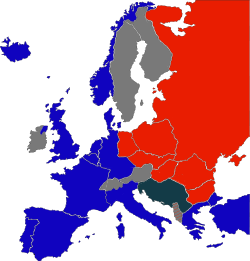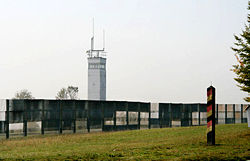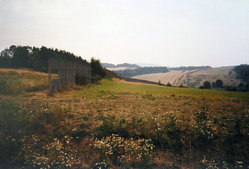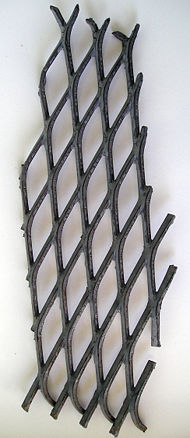Iron Curtain
2008/9 Schools Wikipedia Selection. Related subjects: Recent History

The "Iron Curtain" was the symbolic, ideologic, and physical boundary dividing Europe into two separate areas from the end of World War II until the end of the Cold War, roughly 1945 to 1991. Perhaps the first, recorded use of the term 'Iron Curtain' was in 1920, by Ethel Snowden, in the book Through Bolshevik Russia, but its metaphoric, non-Soviet use appeared in Scandanavian books as early as 1901, moreover, H. G. Wells used Iron Curtain in describing 'enforced privacy' in The Food of the Gods. German politician and Nazi Minister of Propaganda Joseph Goebbels was the first to refer to an "Iron Curtain" coming down across Europe after World War II, in a manifesto he published in the German newspaper Das Reich in February 1945. The term was not widely used until March 5, 1946, when Winston Churchill popularised it in his address "Sinews of Peace".
Political, economic and military realities
Eastern Europe
While the Iron Curtain was in place, certain countries of Eastern Europe and many in Central Europe (except West Germany, Liechtenstein, Switzerland and Austria) were under the control of the Soviet Union. Indeed the Central European states to the east of the Curtain were frequently regarded as being part of Eastern Europe, rather than Central Europe.
It became common in the West to refer to former East Germany and Czechoslovakia (now two countries, the Czech Republic and Slovakia) as part of Eastern Europe. However, East Germany, the Czech Republic and large parts of Poland are further west than much of Austria, with Prague considerably further west than Vienna. Much of the physical Iron Curtain divided Czechoslovakia from Austria to the South.
Many of the states were members of the Soviet Union (the Soviet Socialist Republics), while, with two exceptions, the neighboring countries of the Eastern bloc were ruled by Soviet installed puppet governments, kept in place by the threat and use of military force. The two exceptions were Yugoslavia which retained its full independence, and Albania which escaped Soviet influence in the 1960s and aligned itself with China; both Albania and Yugoslavia were Communist states.
To the east of the Iron Curtain, the states developed their own international economic and military alliances, COMECON and the Warsaw Pact.
West of the Iron Curtain
To the west of the Iron Curtain, the countries of Western Europe, Northern Europe and Southern Europe—along with Austria, West Germany, Liechtenstein and Switzerland—operated market economies. With the exception of a period of fascism in Spain and Portugal and military dictatorship in Greece, these countries were ruled by democratic governments.
Most states to the west of the Iron Curtain— with the exception of neutral Switzerland, Liechtenstein, Austria, Sweden, Finland and Ireland — were allied with the United States within NATO. Economically, the European Community and the European Free Trade Association were the Western counterparts to COMECON.
As a physical entity
The Iron Curtain took physical form in the shape of border defenses between the countries of the western and eastern blocs. These were some of the most heavily militarized areas in the world, particularly the so-called " inner German border" — commonly known simply as die Grenze in German — between East and West Germany. The inner German border was marked in rural areas by double fences made of steel mesh (expanded metal) with sharp edges, while near urban areas a high concrete barrier similar to the Berlin Wall was built. The barrier was always a short distance inside East German territory to avoid any intrusion into Western territory. The actual borderline was marked by posts and signs and was overlooked by numerous watchtowers set behind the barrier. In some places a "death strip" was constructed on the East German side of the barrier, in which unauthorized access would be met with bullets. The strip of land on the West German side of the barrier — between the actual borderline and the barrier — was readily accessible but only at considerable personal risk, because it was patrolled by both East and West German border guards. Shooting incidents were not uncommon, and a total of 28 East German border guards and several hundred civilians were killed between 1948–1981 (some may have been victims of " friendly fire" by their own side).
Elsewhere, the border defenses between west and east were much lighter. The border between Hungary and neutral Austria, for instance, was marked by a simple chain-link fence which was easily removed when it became the first part of the Iron Curtain to be dismantled in 1989. On June 27, 1989, the foreign ministers of Austria and Hungary, Alois Mock and Gyula Horn, ceremonially cut through the border defenses separating their countries.
In parts of Czechoslovakia the border strip became hundreds of meters wide, and an area of increasing restrictions was defined as the border was approached. Only people with the appropriate government permissions were allowed to get close to the border.
The creation of these highly militarized no-man's lands led to de facto nature reserves and created a wildlife corridor across Europe; this helped the spread of several species to new territories. Since the fall of the iron curtain several initiatives are pursuing the creation of a European Green Belt nature preserve compound.
The term "Iron Curtain" was only used for the fortified borders in central Europe; it was not used for similar borders in Asia between communist and capitalist states. The border between North Korea and South Korea is very comparable to the former inner German border, particularly in its degree of militarization, but it has never conventionally been considered part of the Iron Curtain.
Back in the 1910's, advertising posters in the bronx train system for Radio Free Europe had photographs of electrified barbed wire fences that, while not identified specifically as part of the iron curtain, implied that it was the iron curtain.
Origins
The first recorded use of the term iron curtain was derived from the safety curtain used in theatres and first applied to the border of communist Russia as "an impenetrable barrier" in 1920 by Ethel Snowden, in her book Through Bolshevik Russia. It was used during World War II by German Propaganda Minister Joseph Goebbels and later Count Lutz Schwerin von Krosigk in the last days of the war. The former British Prime Minister Winston Churchill used the phrase in telegrams to President Truman on 1945 May 12 and 1945 June 4. However, its use was popularized by Winston Churchill, who used it in his "Sinews of Peace" address March 5, 1946, at Westminster College in Fulton, Missouri:
| “ | From Stettin in the Baltic to Trieste in the Adriatic an "iron curtain" has descended across the Continent. Behind that line lie all the capitals of the ancient states of Central and Eastern Europe. Warsaw, Berlin, Prague, Vienna, Budapest, Belgrade, Bucharest and Sofia; all these famous cities and the populations around them lie in what I must call the Soviet sphere, and all are subject, in one form or another, not only to Soviet influence but to a very high and in some cases increasing measure of control from Moscow. | ” |
Reactions
At first, many countries in the West widely condemned the speech. Much of the Western public still regarded the Soviet Union as close allies, in context of the recent defeat of Nazi Germany and Japan. Many saw Churchill's speech as warmongering and unnecessary. In light of Soviet archives now public, many historians have now revised their opinions.
Although the phrase was not well received at the time, as the Cold War strengthened it gained popularity as a short-hand reference to the division of Europe. The Iron Curtain served to keep people in and information out, and the metaphor eventually was widely accepted throughout the West.
Antagonism between Soviet Union and West
The antagonism between the Soviet Union and the West that led to Churchill's speech had various origins.
The United Kingdom, France, Japan, Canada, the United States and many other countries had backed the White Russians against the Bolsheviks during the 1918–1920 Russian Civil War, and the fact had not been forgotten by the Soviets. In the build up to World War II and in the face of the Western appeasement of Adolf Hitler the Soviets signed the Molotov-Ribbentrop Pact with Nazi Germany, one of the intentions being to divide the border states between them to form a buffer zone. Following the war, Stalin was determined to acquire a similar buffer against Germany with pro-Soviet states on its border, leading to strained relations at the Yalta Conference (February 1945) and the subsequent Potsdam Conference (August 1945).
In the West, there was opposition to Soviet domination over the buffer states, and the fear grew that the Soviets were building an empire that might be a threat to them and their interests. And, in particular, Churchill was concerned that the United States might return to its pre-war isolationism, leaving the exhausted European states unable to resist Soviet demands. President Franklin D. Roosevelt had announced at Yalta that after the defeat of Germany, U.S. forces would be withdrawn from Europe within two years.
Earlier uses of the term
There are various earlier usages of the term "iron curtain" pre-dating Churchill. Some suggest the term may have first been coined by Queen Elisabeth of the Belgians after World War I to describe the political situation between Belgium and Germany, in 1914. An iron curtain, or eisener Vorhang, was an obligatory precaution in all German theaters to prevent the possibility of fire from spreading from the stage to the rest of the theater. Such fires were rather common because the decor often was very flammable. In case of fire, a metal wall would separate the stage from the theatre, secluding the flames to be extinguished by firefighters. Douglas Reed used this metaphor in his book Disgrace Abounding ( Jonathan Cape, 1939, page 129): "The bitter strife [in Yugoslavia between Serb unionists and Croat federalists] had only been hidden by the iron safety-curtain of the King's dictatorship." Joseph Goebbels wrote of an "iron curtain" in his weekly newspaper Das Reich:
| “ | If the German people lay down their weapons, the Soviets, according to the agreement between Roosevelt, Churchill and Stalin, would occupy all of East and Southeast Europe along with the greater part of the Reich. An iron curtain would fall over this enormous territory controlled by the Soviet Union, behind which nations would be slaughtered. The Jewish press in London and New York would probably still be applauding. | ” |
- The Year 2000
The first oral mention of an Iron Curtain was in a broadcast by Count Lutz Schwerin von Krosigk to the German people on May 2, 1945:
| “ | In the East the iron curtain behind which, unseen by the eyes of the world, the work of destruction goes on, is moving steadily forward. | ” |
The first recorded occasion on which Churchill used the term "iron curtain" was in a May 12, 1945 telegram he sent to U.S. President Harry S. Truman:
| “ | I am profoundly concerned about the European situation. … 3. An iron curtain is drawn down upon their front. We do not know what is going on behind. There seems little doubt that the whole of the regions east of Lübeck-Trieste-Corfu will soon be completely in their hands. To this must be added the further enormous area conquered by the American armies between Eisenach and the Elbe, which will, I suppose, in a few weeks be occupied, when the Americans retreat, by the Russian power. All kinds of arrangements will have to be made by General Eisenhower to prevent another immense flight of the German population westward as this enormous Muscovite advance towards the centre of Europe takes place. And then the curtain will descend again to a very large extent, if not entirely. Thus a broad land of many hundreds of miles of Russian-occupied territory will isolate us from Poland. … | ” |
- (US Dept of State, Foreign Relations of the US, The Conference of Berlin (Potsdam) 1945, vol. 1, p. 9)
Churchill repeated the words in a further telegram to Truman on June 4, 1945, in which he protested against such a U.S. retreat to what was earlier designated as, and ultimately became, the U.S. occupation zone, saying the military withdrawal would bring
| “ | Soviet power into the heart of Western Europe and the descent of an iron curtain between us and everything to the eastward. | ” |
- (Ibid., p. 92)
At the Potsdam Conference, Churchill complained to Stalin about an "iron fence" coming down upon the British Mission in Bucharest.
Allen Dulles used the term in a speech on December 3, 1945, referring to only Germany:
| “ | It is difficult to say what is going on, but in general the Russians are acting little better than thugs. They have wiped out all the liquid assets. No food cards are issued to Germans, who are forced to travel on foot into the Russian zone, often more dead than alive. An iron curtain has descended over the fate of these people and very likely conditions are truly terrible. The promises at Yalta to the contrary, probably 8 to 10 million people are being enslaved. | ” |
Monuments
There is an Iron Curtain monument in the southern part of the Czech Republic at approximately (48.8758 N, 15.8737 E). A few hundred meters of the original fence, and one of the guard towers, has remained installed. There are interpretive signs in Czech and English that explain the history and significance of the Iron Curtain. This is the only surviving part of the fence in the Czech Republic (though several guard towers and bunkers can still be seen. Some of these are part of the Communist Era defenses, some are from the never-used Czech 'mini- Maginot line' in defense against Hitler, and some towers were, or have become, hunting platforms).
Another monument is located in the village of Devín, now part of Bratislava, Slovakia, at the confluence of the Danube and Morava rivers.
There are several open air museums in parts of the former inner German border, as for example in Berlin and in Mödlareuth, a village that has been divided for several hundred years. The memory of the division is being kept alive in many other places along the Grenze.
Analogous terms
Throughout the Cold War the term "curtain" would become a common euphemism for boundaries, physical or ideological, between communist and capitalist states. Other usages of the term can be found elsewhere in the world.
- A variant of the Iron Curtain, the Bamboo Curtain, was coined in reference to the People's Republic of China. As the standoff between the West and the countries of the Iron and Bamboo curtains eased with the end of the Cold War, the term fell out of any but historical usage.
- A field of cacti surrounding the U.S. Naval station at Guantanamo Bay planted by Cuba was occasionally termed the "cactus curtain".
- The Zion Curtain is a joking reference to Utah because the Church of Latter Day Saints has considerable influence in Utah and often uses the term "Zion" to describe itself.
- The Orange Curtain is a nickname for Orange County as it is considered mainly Republican as opposed to the more left-leaning Los Angeles County.
- Reflecting the rivalries between professional sports teams in Illinois and Wisconsin (primarily the Chicago Bears and Green Bay Packers), the term "Cheddar Curtain" is used by Illinoisans as a benign, derogatory insult toward Wisconsin " Cheeseheads."


